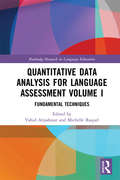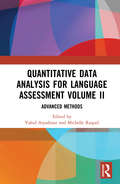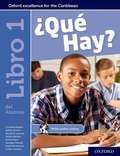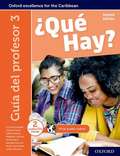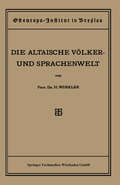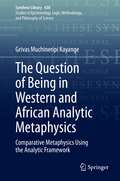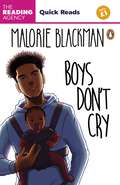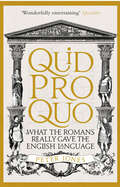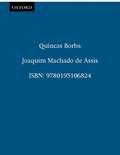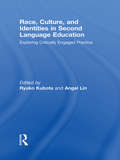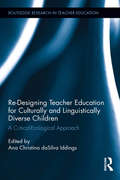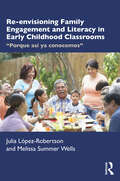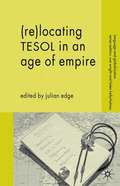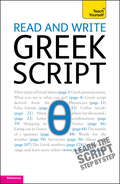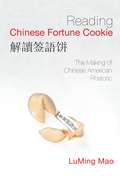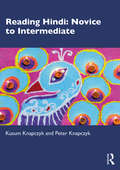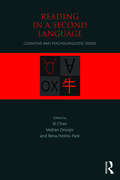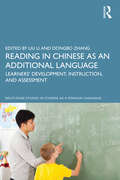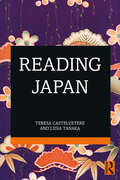- Table View
- List View
Quantitative Data Analysis for Language Assessment Volume I: Fundamental Techniques (Routledge Research in Language Education)
by Vahid Aryadoust Michelle RaquelQuantitative Data Analysis for Language Assessment Volume I: Fundamental Techniques is a resource book that presents the most fundamental techniques of quantitative data analysis in the field of language assessment. Each chapter provides an accessible explanation of the selected technique, a review of language assessment studies that have used the technique, and finally, an example of an authentic study that uses the technique. Readers also get a taste of how to apply each technique through the help of supplementary online resources that include sample data sets and guided instructions. Language assessment students, test designers, and researchers should find this a unique reference as it consolidates theory and application of quantitative data analysis in language assessment.
Quantitative Data Analysis for Language Assessment Volume II: Advanced Methods
by Vahid Aryadoust Michelle RaquelQuantitative Data Analysis for Language Assessment Volume II: Advanced Methods demonstrates advanced quantitative techniques for language assessment. The volume takes an interdisciplinary approach and taps into expertise from language assessment, data mining, and psychometrics. The techniques covered include Structural Equation Modeling, Data Mining, Multidimensional Psychometrics and Multilevel Data Analysis.Volume II is distinct among available books in language assessment, as it engages the readers in both theory and application of the methods and introduces relevant techniques for theory construction and validation. This book is highly recommended to graduate students and researchers who are searching for innovative and rigorous approaches and methods to achieve excellence in their dissertations and research. It is also a valuable source for academics who teach quantitative approaches in language assessment and data analysis courses.
Quantitative Data Analysis for Language Assessment Volume II: Advanced Methods
by Vahid Aryadoust Michelle RaquelQuantitative Data Analysis for Language Assessment Volume II: Advanced Methods demonstrates advanced quantitative techniques for language assessment. The volume takes an interdisciplinary approach and taps into expertise from language assessment, data mining, and psychometrics. The techniques covered include Structural Equation Modeling, Data Mining, Multidimensional Psychometrics and Multilevel Data Analysis.Volume II is distinct among available books in language assessment, as it engages the readers in both theory and application of the methods and introduces relevant techniques for theory construction and validation. This book is highly recommended to graduate students and researchers who are searching for innovative and rigorous approaches and methods to achieve excellence in their dissertations and research. It is also a valuable source for academics who teach quantitative approaches in language assessment and data analysis courses.
Que Hay: Libro Del Alumno 1
by Christine Haylett Jeffrey Britton Margaret Leacock Yorley Mendez Georgia Pinnock Angie Ramnarine Lesbia Tesorero?Que Hay? is the market-leading Spanish course for 11-14-year-olds across the Caribbean. Newly updated, it is as relevant and lively as ever. This comprehensive course follows an immersive approach that encourages students to enjoy and fully engage with both the language and the culture.
Que Hay: Teacher's Guide 3
by Christine Haylett Jeffrey Britton Margaret Leacock Yorley Mendez Georgia Pinnock Angie Ramnarine Lesbia Tesorero¿Qué Hay? is the market-leading Spanish course for 11-14-year-olds across the Caribbean. Newly updated, it is as relevant and lively as ever. Whether you are an experienced teacher looking for inspiration or a new teacher looking for support in teaching this course for the first time, there is something in this Teacher's Guide for you.
Quellen und Studien: Sechste Abteilung: Sprachwissenschaft, I. Heft: Die Altaische Völker- und Sprachenwelt
by Heinrich WinklerDieser Buchtitel ist Teil des Digitalisierungsprojekts Springer Book Archives mit Publikationen, die seit den Anfängen des Verlags von 1842 erschienen sind. Der Verlag stellt mit diesem Archiv Quellen für die historische wie auch die disziplingeschichtliche Forschung zur Verfügung, die jeweils im historischen Kontext betrachtet werden müssen. Dieser Titel erschien in der Zeit vor 1945 und wird daher in seiner zeittypischen politisch-ideologischen Ausrichtung vom Verlag nicht beworben.
The Question of Being in Western and African Analytic Metaphysics: Comparative Metaphysics Using the Analytic Framework (Synthese Library #438)
by Grivas Muchineripi KayangeThe main aim of this book is to discuss fundamental developments on the question of being in Western and African philosophy using analytic metaphysics as a framework. It starts with the two orthodox responses to the question of being, namely, the subject-verb-object language view and the rheomodic language view. In the first view, being is conceived through the analysis of language structure, where it is represented by subjects (particulars), objects, and relations (often universals). In the second view, there are different variations; however, the common idea is that the world's structure is revealed in the root verb of terms. This suggests a holistic and dynamic conception of being, where everything is in a continuous process of action. The book builds on analytic philosophy and explores metaphysical concepts such as space-time, modality, causation, indeterminism versus determinism, and mind and body. The book shows that in both Western and African thought, (i) similarities in different studies confirm that philosophy is a universal activity, (ii) differences within a context and beyond confirm the perspectival nature of human knowledge as individuals attempt to interpret reality, and (iii) language influences the conceptualization of being in a particular area. One of the novel aspects is the development of visual and mathematical African models of space and time.
Quick Reads Penguin Readers: Boys Don’t Cry
by Malorie BlackmanA gripping Quick Read about family and growing up from bestselling author, Malorie Blackman.Seventeen-year-old Dante is waiting for his A-level results. He’s got it all planned out. If his results are good, he’ll go to uni and study to be a journalist.But while he’s waiting, the doorbell rings and it’s his ex-girlfriend. She’s carrying a baby – his baby.Dante agrees to look after the baby for an hour or two. Then his ex doesn’t come back, and Dante’s plans have to change. With the help of his father and brother, Dante must learn how to be a single parent.A gripping and original story about love, relationships and growing up the hard way.
Quid Pro Quo: What the Romans Really Gave the English Language (Classic Civilisations)
by Peter JonesDid you know that the word 'prestige' derives from the Latin word for 'illusion'? Or that 'infantry' stems from a Latin word meaning one who could not speak? In this original and highly entertaining book, Peter Jones reveals the roots of Latin words that are now common in the English language and shows how Romans actually used them in the ancient world. Covering every aspect of Roman life - from politics, philosophy, religion and the arts, to technology, warfare, medicine and botany - Quid Pro Quo highlights the vital role Latin has played in the creation of our vast vocabulary.
Quincas Borba (Library of Latin America)
by Joaquim Machado de AssisAlong with The Posthumous Memoirs of Brás Cubas and Dom Casmurro, Quincas Borba is one of Machado de Assis' major works and indeed one of the major works of nineteenth century fiction. With his uncannily postmodern sensibility, his delicious wit, and his keen insight into the political and social complexities of the Brazilian Empire, Machado opens a fascinating world to English speaking readers. When the mad philosopher Quincas Borba dies, he leaves to his friend Rubião the entirety of his wealth and property, with a single stipulation: Rubião must take care of Quincas Borba's dog, who is also named Quincas Borba, and who may indeed have assumed the soul of the dead philosopher. Flush with his newfound wealth, Rubião heads for Rio de Janeiro and plunges headlong into a world where fantasy and reality become increasingly difficult to keep separate. Brilliantly translated by Gregory Rabassa, Quincas Borba is a masterful satire not only on life in Imperial Brazil but the human condition itself.
Race, Culture, and Identities in Second Language Education: Exploring Critically Engaged Practice
by Ryuko KubotaThe concept and construct of race is often implicitly yet profoundly connected to issues of culture and identity. Meeting an urgent need for empirical and conceptual research that specifically explores critical issues of race, culture, and identities in second language education, the key questions addressed in this groundbreaking volume are these: How are issues of race relevant to second language education? How does whiteness influence students’ and teachers’ sense of self and instructional practices? How do discourses of racialization influence the construction of student identities and subjectivities? How do discourses on race, such as colorblindness, influence classroom practices, educational interventions, and parental involvement? How can teachers transform the status quo? Each chapter is grounded in theory and provides implications for engaged practice. Topics cover a wide range of themes that emerge from various pedagogical contexts. Authors from diverse racial/ethnic/cultural backgrounds and geopolitical locations include both established and beginning scholars in the field, making the content vibrant and stimulating. Pre-reading Questions and Discussion Questions in each chapter facilitate comprehension and encourage dialogue.
Race, Culture, and Identities in Second Language Education: Exploring Critically Engaged Practice
by Ryuko Kubota Angel M. Y. LinThe concept and construct of race is often implicitly yet profoundly connected to issues of culture and identity. Meeting an urgent need for empirical and conceptual research that specifically explores critical issues of race, culture, and identities in second language education, the key questions addressed in this groundbreaking volume are these: How are issues of race relevant to second language education? How does whiteness influence students’ and teachers’ sense of self and instructional practices? How do discourses of racialization influence the construction of student identities and subjectivities? How do discourses on race, such as colorblindness, influence classroom practices, educational interventions, and parental involvement? How can teachers transform the status quo? Each chapter is grounded in theory and provides implications for engaged practice. Topics cover a wide range of themes that emerge from various pedagogical contexts. Authors from diverse racial/ethnic/cultural backgrounds and geopolitical locations include both established and beginning scholars in the field, making the content vibrant and stimulating. Pre-reading Questions and Discussion Questions in each chapter facilitate comprehension and encourage dialogue.
Re-Designing Teacher Education for Culturally and Linguistically Diverse Students: A Critical-Ecological Approach (Routledge Research in Teacher Education)
by Ana Christina Da Silva IddingsThrough a critical-ecological lens, this book examines how to prepare preservice teachers to be resourceful and responsive practitioners in addressing the intellectual needs of children often labeled as "culturally and linguistically diverse." It explores a comprehensive re-design of a teacher education program grounded in research on the complex factors that affect the teaching and learning of linguistically and culturally diverse children. Re-Designing Teacher Education for Culturally and Linguistically Diverse Students challenges hegemonic cultural and linguistic norms, quantitative and static views of "resources," the impact of U.S. education policy, and the limited attention to the agency, identities, and strategic actions of diverse students and their families.
Re-Designing Teacher Education for Culturally and Linguistically Diverse Students: A Critical-Ecological Approach (Routledge Research in Teacher Education)
by Ana Christina Da Silva IddingsThrough a critical-ecological lens, this book examines how to prepare preservice teachers to be resourceful and responsive practitioners in addressing the intellectual needs of children often labeled as "culturally and linguistically diverse." It explores a comprehensive re-design of a teacher education program grounded in research on the complex factors that affect the teaching and learning of linguistically and culturally diverse children. Re-Designing Teacher Education for Culturally and Linguistically Diverse Students challenges hegemonic cultural and linguistic norms, quantitative and static views of "resources," the impact of U.S. education policy, and the limited attention to the agency, identities, and strategic actions of diverse students and their families.
Re-envisioning Family Engagement and Literacy in Early Childhood Classrooms: "Porque así ya conocemos"
by Julia López-Robertson Melissa Summer WellsFamilies are resources that are extremely powerful and important for young learners from minoritized backgrounds, yet such families are often overlooked, silenced, or ostracized. This book presents a much-needed framework for family and community engagement in the early childhood and elementary literacy classroom that embraces and foregrounds students’ unique cultural backgrounds. This book spotlights the families of minoritized learners and the crucial role that they play in building dynamic and inspiring environments for learning. To re-envision the engagement of these families in the early childhood classroom, the book provides an accessible understanding of Yosso’s theory of community cultural wealth. Covering key topics such as children’s literature and digital tools, the book features strategies for implementing culturally responsive classroom practices to create positive home–school partnerships. Each chapter highlights one type of capital in community cultural wealth—aspirational, linguistic, familial, social, navigational, and resistant—and gives teachers guidance on working with and supporting the efforts of families both inside and outside of the classroom. This book is an essential resource to inform current and future early childhood educators on how to gain deeper understandings of what families—especially from Communities of Color—already are doing for the education of their children, and how best to support them.
Re-envisioning Family Engagement and Literacy in Early Childhood Classrooms: "Porque así ya conocemos"
by Julia López-Robertson Melissa Summer WellsFamilies are resources that are extremely powerful and important for young learners from minoritized backgrounds, yet such families are often overlooked, silenced, or ostracized. This book presents a much-needed framework for family and community engagement in the early childhood and elementary literacy classroom that embraces and foregrounds students’ unique cultural backgrounds. This book spotlights the families of minoritized learners and the crucial role that they play in building dynamic and inspiring environments for learning. To re-envision the engagement of these families in the early childhood classroom, the book provides an accessible understanding of Yosso’s theory of community cultural wealth. Covering key topics such as children’s literature and digital tools, the book features strategies for implementing culturally responsive classroom practices to create positive home–school partnerships. Each chapter highlights one type of capital in community cultural wealth—aspirational, linguistic, familial, social, navigational, and resistant—and gives teachers guidance on working with and supporting the efforts of families both inside and outside of the classroom. This book is an essential resource to inform current and future early childhood educators on how to gain deeper understandings of what families—especially from Communities of Color—already are doing for the education of their children, and how best to support them.
(re-)locating Tesol In An Age Of Empire (PDF)
by Julian EdgeAre TESOL professionals now fairly seen as agents of a new English-speaking empire? Or, if they wish to distance themselves from this role, are there ways of working and living that would make this differentiation clear? An international group of authors put forward their differing proposals for the development of TESOL.
Read and write Greek script: Teach Yourself (Read and Write Languages)
by Sheila Hunt Dennis CouniacisMaster Greek script with this straightforward guide from Teach Yourself - the No. 1 brand in language learning. Read and write Greek script is a clear step-by-step guide to the written language, with plenty of examples from real-life texts to show how it works in context and lots of exercises to reinforce your learning. This new edition has an easy-to-read page design.Now fully updated to make your language learning experience fun and interactive. You can still rely on the benefits of a top language teacher and our years of teaching experience, but now with added learning features within the course and online. Learn effortlessly with new, easy-to-read page design and interactive features: NOT GOT MUCH TIME?One, five and ten-minute introductions to key principles to get you started.AUTHOR INSIGHTSLots of instant help with common problems and quick tips for success, based on the author's many years of experience.USEFUL VOCABULARYEasy to find and learn, to build a solid foundation for speaking.TEST YOURSELFTests in the book and online to keep track of your progress.EXTEND YOUR KNOWLEDGEExtra online articles at: www.teachyourself.com to give you a richer understanding of the culture and history of Greece.TRY THISInnovative exercises illustrate what you've learnt and how to use it.
Reading Chinese Fortune Cookie: The Making of Chinese American Rhetoric
by LuMing MaoLuMing Mao offers an important discussion of the rhetoric of Chinese American speakers, which has wide implications for the teaching of writing in English and for our understanding of cross-cultural influences in discourse. Recent scholarship tends to explain such influences as contributing to language hybridity---an advance over the traditional "deficit model." But Mao suggests that the "hybridity" approach is perhaps too arid or sanitized, missing rich nuances of mutual exchange, resistance, or even subversion. Working from Ang's concept of "togetherness in difference," Mao suggests that speakers of hybrid discourse may not be attempting the standard (and failing), but instead may be deliberately importing cultural material to create a distance between themselves and the standard. This practice, over time, becomes a process that transforms English, enriching and enlarging it through the infusion of non-Western discourse features, subverting power structures, and even providing unique humorous touches. Of interest to scholars in composition, cultural studies, and linguistics as well, Reading Chinese Fortune Cookie leads in an important new direction for both our understanding and our teaching of English.
Reading Hindi: Novice to Intermediate
by Kusum Knapczyk Peter KnapczykReading Hindi: Novice to Intermediate is an innovative collection of graded readings that are both accessible in language and engaging in content, specifically designed for adult learners of Hindi. Ideal for those just starting out in Hindi, the texts provide culturally rich content written in simple, level-appropriate language, with a range of activities to reinforce learning. The graded readings support the learner as they build their confidence with the language, gradually encountering a wider range of grammar constructions and vocabulary as the book progresses. Reading Hindi can be used alongside a main textbook and is ideal for both class-use and independent study.
Reading in a Second Language: Cognitive and Psycholinguistic Issues
by Xi Chen Rena Helms-Park Vedran DronjicReading in a Second Language offers a comprehensive survey of the phenomenon and process of reading in a second language, with graduate and upper-level undergraduate students in second language acquisition, psycholinguistics, and applied psychology as its primary audience. The book explores reading processes from a number of complementary standpoints, integrating perspectives from fields such as first and second language reading, second language acquisition, linguistics, psycholinguistics, and cognitive neuroscience. The first half examines major factors in second language reading: types of scripts, the cognitive and neural substrates of reading; metalinguistic awareness, word recognition, language transfer, and lexical knowledge. The second part of the book discusses the social and educational contexts in which reading development occurs, including issues related to pedagogy, the use of technology in the classroom, reading disorders, and policy making. Reading in a Second Language provides students with a full, logically organized overview of the primary factors that shape reading development and processes in a second language.
Reading in a Second Language: Cognitive and Psycholinguistic Issues
by Xi Chen Rena Helms-Park Vedran DronjicReading in a Second Language offers a comprehensive survey of the phenomenon and process of reading in a second language, with graduate and upper-level undergraduate students in second language acquisition, psycholinguistics, and applied psychology as its primary audience. The book explores reading processes from a number of complementary standpoints, integrating perspectives from fields such as first and second language reading, second language acquisition, linguistics, psycholinguistics, and cognitive neuroscience. The first half examines major factors in second language reading: types of scripts, the cognitive and neural substrates of reading; metalinguistic awareness, word recognition, language transfer, and lexical knowledge. The second part of the book discusses the social and educational contexts in which reading development occurs, including issues related to pedagogy, the use of technology in the classroom, reading disorders, and policy making. Reading in a Second Language provides students with a full, logically organized overview of the primary factors that shape reading development and processes in a second language.
Reading in Chinese as an Additional Language: Learners’ Development, Instruction, and Assessment (Routledge Studies in Chinese as a Foreign Language)
by Liu Li Dongbo ZhangReading in Chinese as an Additional Language focuses on Chinese literacy acquisition, which has been considered most difficult by both learners and teachers of Chinese as an additional language (CAL). Three major areas are covered: (1) acquisition of Chinese characters; (2) reading comprehension subskills and reader’s identity; (3) reading instruction and assessment. The first part delves into the foundation of Chinese literacy development—how to learn and teach Chinese characters. The second part examines various learners’ reading comprehension subskills, as well as the evolution of learners’ literacy identity. The third part explores effective instructional methods and assessment practices for CAL reading development. Theoretically, this book provides frameworks and evidence from both cognitive and sociocultural perspectives on the nature of CAL reading development. Pedagogically, the book showcases how to teach and assess CAL reading skills. Methodologically, this book includes empirical studies using both qualitative and quantitative methods. In terms of scope, the book covers a much broader spectrum of issues about CAL reading research and classroom teaching than has previously been available. Writing is also discussed in several chapters. In terms of technology, the book includes discussion on how the use of computers, the Internet, and social media impacts students’ Chinese literacy acquisition. This book will help CAL researchers and educators better understand the nature of CAL reading development and become well informed about CAL classroom teaching and assessment, including the application of interactive approaches to teaching and assessing diverse reading skills.
Reading in Chinese as an Additional Language: Learners’ Development, Instruction, and Assessment (Routledge Studies in Chinese as a Foreign Language)
by Liu Li Dongbo ZhangReading in Chinese as an Additional Language focuses on Chinese literacy acquisition, which has been considered most difficult by both learners and teachers of Chinese as an additional language (CAL). Three major areas are covered: (1) acquisition of Chinese characters; (2) reading comprehension subskills and reader’s identity; (3) reading instruction and assessment. The first part delves into the foundation of Chinese literacy development—how to learn and teach Chinese characters. The second part examines various learners’ reading comprehension subskills, as well as the evolution of learners’ literacy identity. The third part explores effective instructional methods and assessment practices for CAL reading development. Theoretically, this book provides frameworks and evidence from both cognitive and sociocultural perspectives on the nature of CAL reading development. Pedagogically, the book showcases how to teach and assess CAL reading skills. Methodologically, this book includes empirical studies using both qualitative and quantitative methods. In terms of scope, the book covers a much broader spectrum of issues about CAL reading research and classroom teaching than has previously been available. Writing is also discussed in several chapters. In terms of technology, the book includes discussion on how the use of computers, the Internet, and social media impacts students’ Chinese literacy acquisition. This book will help CAL researchers and educators better understand the nature of CAL reading development and become well informed about CAL classroom teaching and assessment, including the application of interactive approaches to teaching and assessing diverse reading skills.
Reading Japan
by Teresa Castelvetere Lidia TanakaReading Japan offers the student readings on geopolitics, education, language, Japanese-ness and ethnicity, gender and history, with the dual aims of broadening students’ understanding of Japan and of providing opportunities to read authentic Japanese texts. Each chapter contains an essay in English, a selection of readings in Japanese, comprehensive vocabulary lists, discussion questions and a list of sources and additional readings. Pitched at Intermediate to Advanced and B1-C1 level, this reader is not simply a language textbook; it offers students a chance to learn and think in depth about Japan as they build confidence in reading real-world Japanese texts.
